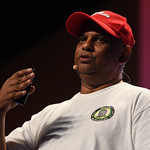Exclusive Interview: AirAsia's Tony Fernandes Reveals Digital Success Route
In the cut-throat, hyper-competitive and no-holds-barred work of budget airlines, AirAsia reigns.
Since it started its operations in 1996, the Malaysia-based budget carrier has expanded. It flies to 165 destinations in 25 countries, making it the largest Malaysian airline by fleet size and destinations.
The airline is also going long. AirAsia X now takes on other international budget airlines by taking lucrative long-haul routes.
These achievements are remarkable in a region that is littered with budget airline upstarts. Many are hoping to cash in on the growing desire to travel coupled with economic prosperity. Not to be outdone, the full-service national carriers are using deep pockets and international routes to muscle in.
Yet, AirAsia has continued to soar.
Decisions at Lightspeed
Digital fuels AirAsia's success. It was part of a decision by Tan Sri Dr. Tony Fernandes from the onset. The group chief executive officer knew optimization and leanness would matter in the long run. So, he invested heavily in digitizing.
“It gave me the flexibility to bring things together and split them up. It allowed me to create more focus in key areas,” said Fernandes at a recent CDOTrends interview.
AirAsia's foray into lifestyle platforms offers an example of this decision agility.
The airline's primary platform was airasia.com. Fernandes and his team also saw value in creating a neutral platform, christened BigLife. It was to be a lifestyle platform that rolled the benefits of Kayak, Groupon, eBay, and TripAdvisor into one.
“So the question was would anyone buy anything else on airasia.com. That is why we came up with a neutral platform BigLife,” said Fernandes.
BigLife was to feature the myriad of digital products and services under the company’s digital tech arm Redbeat Ventures. These included the company’s online wallet BigPay, its inflight connectivity platform Rokki, the OurShop online marketplace and logistics services RedBox and RedCargo.
Fernandes quickly saw the move would take away eyeballs and resources from the airasia.com platform. It meant getting into another cut-throat business: e-commerce.
Meanwhile, consumer behaviors began to shift. They are buying products from brands they trust, and not necessarily neutral platforms.
“People buy cabbage from Amazon now. So, if the value and product experience were good, people will buy anything from airasia.com. I have spent millions building airasia.com, so let’s milk that brand,” he reasoned.
So, Fernandes did in a big way. Instead of building a second platform, he decided to expand airasia.com’s “usefulness.” It now features all the products that BigLife was to have.
"BigLife as a platform closed down. BigLife remains a loyalty product, but the platform is gone. I sat there, and I thought, why am I building another platform when I already have the biggest platform?” he said.
Fernandes attributed this quick shift of thinking to digitalization. "If I have a problem, it is not a departmental problem but a company problem. So, the question is, how can I put together an agile team to fix it? It is the vision I hope to emulate [through digitalization]. And with that, we create better products, and we really harness the power of AirAsia."
Digitalization helped AirAsia to breakdown interdepartmental silos. "If we stay as silos, we are screwed,” he said, adding that it is one of the biggest challenges for many older airlines.
Leadership Augmentation
AirAsia was founded on an idea and a “gut feel.”
Today, AirAsia is fueled by data-driven decisions. It has helped the airline spur on-time performance, eliminate wastage, and shave off fuel burn.
“So as a company, we have become more data-driven. And I think that has led to better decisions. Before it was all about he said, she said,” said Fernandes.
Digitalization keeps AirAsia’s culture afloat and pointed in the right direction. It also hones their competitiveness at a time where full-service airlines are eyeing budget airline market share.
For example, recent reports highlighted a deepening relationship between two flagship rivals, Malaysian Airlines and Singapore Airlines (SIA). Going beyond codeshare, the two airlines signed a memorandum of understanding that covered a host of areas. One key focus is taking on AirAsia, which SIA previously tried with Tiger Airlines and Scoot. Tiger Airlines was later merged with Scoot.
Fernandes scoffed at the idea of these rivals working together. “Who cares if they do. I always need to be better than what the market throws at me. That is just a fact. So if SIA and Malaysia Airlines get together, we compete.”
Staying Human
Fernandes might be proud of his company’s role in embracing digitization. But he does not see data-driven, empirical decisions ever replacing gut-based ones.
“I do not want that to disappear. For example, no one would have started going to Bandung based on data. There were no passengers there. Sometimes, you need to be a pioneer,” he said.
Fernandes also advocates in keeping the human touch alive. “Because that is the life and soul of what AirAsia is.”
It goes back to the days when Fernandes first mulled the idea of a budget airline. "If you had put all the available data in a supercomputer to find out whether I should start an airline business, the supercomputer would have said it would be a stupid idea. Because no sensible man would be able to say that will work.”
AirAsia worked, despite the apparent odds. “So, data can only go so far. At one point, you have to say this is what you want to do. That is what leadership is about.”








